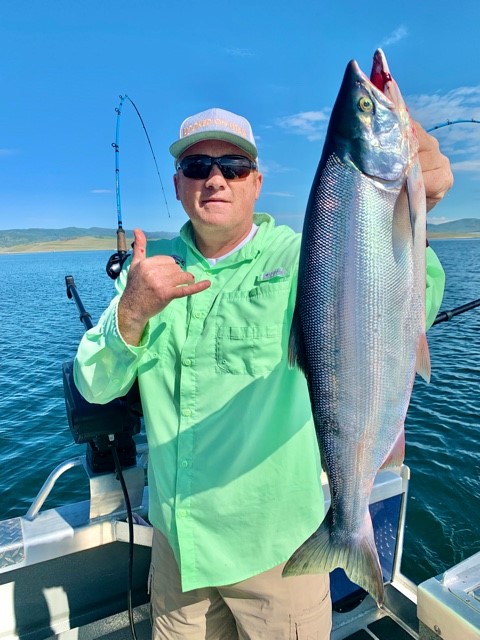Kokanee Fishing Advice From a Career Outdoorsman
By Heather Madsen
Summer is winding down, which means it’s prime time for some late-summer/early-fall fishing. Depending on where you live you should be able to catch anything from bass to trout, but if you’re lucky you might even get a chance to fish for kokanee. Kokanee are the freshwater, landlocked version of sockeye salmon, and are a fun and delicious fishing deviation from your regular season species. If you’ve never fished kokanee, or if you just want to make sure your game is up to par this season, read on to learn some tips from Gary Winterton, seasoned angler, and the creator of the Hooked on Utah TV show.
Winterton grew up in Utah, at the mouth of Provo Canyon, which meant that he had almost unlimited access to a perfect fishing spot. He first started out fishing with his father, and in the run-off creek by his house. As Winterton put it, “I spent summers fishing with my dad, and fall hunting with my uncle. Then fishing season closed in November, and I had all winter to think about it and get juiced up for the next season.” As he matured into his 20’s, he also started competing in professional bass fishing tournaments and joining the local clubs.
As an adult he took a turn into the corporate world and worked as the president for an internet marketing company. However, he realized that he didn’t love it as much as he loved the outdoors and he began his adventure in establishing Hooked on Utah. With the help of a friend, he created a pilot sample of the sort of outdoor show he wanted to create and sent it to a couple of different stations. Luckily his demo was a hit and soon after he quit his corporate job to be a full time expert angler and outdoorsman. His success continues today and Hooked on Utah is currently the number one outdoors show in the state. With all of his experience and passion, Winterton has a lot of advice on how to better your fishing techniques, but here are a few of his top tips that will help you snag a kokanee of your own this year.
 Firstly, you can’t catch a fish if you don’t know where they are. Take the time to get to know the water and area you’re in. Use your fish finder and pay attention to what it tells you. If you can find where the fish are schooling, and at what depths they’re sticking to, you’ll have the information you need to properly set your lines.
Firstly, you can’t catch a fish if you don’t know where they are. Take the time to get to know the water and area you’re in. Use your fish finder and pay attention to what it tells you. If you can find where the fish are schooling, and at what depths they’re sticking to, you’ll have the information you need to properly set your lines.
Speaking of lines, make sure you set them to length that will fit your area and weather. Most out-of-the-package lines are around 30 inches. In mid summer the water is warmer, so the fish will be more active and willing to bite. This means you’ll want to use a shorter line of maybe 12 to 18 inches. However, with the weather starting to cool off, you’ll need to adjust your length to reach the fish that are staying deeper in the water and that are less likely to jump at your bait. The fish also slow down with the colder temperatures, so take that into account when you set the speed on your boat.
The next part of your equipment that you really need to pay attention to is your lures. Start with a wide color range on your squids or dodgers. Winterton usually starts four lines, each one with their own unique color. His favorite starting palette consists of pinks, oranges, greens, and a mix--usually with fire tiger, or whatever else he has in his tackle box that’s similar. Then he tips each of the lures with something soft and scented, like corn or a maggot. He does this because kokanee will come up behind the lure and nibble on it to test if it’s soft and edible. The bait will trick them into attaching more firmly onto your hook. Start trolling with your lures and watch which ones the fish are responding to best. If you’re getting more bites on your green ones--switch all of your lines to that lure. Same thing goes for the type of lure you’re using. Don’t be afraid to switch things up if you notice a pattern.
Finally, you’ve got to think about how you’re maneuvering your boat through the water. Winterton says that one of the biggest mistakes he sees people making when trolling, is travelling in a straight line. A more efficient method is to take big, wide “S” turns. This way the lines on either side of your boat will travel at slightly different speeds. If you keep picking up fish on the side of the boat that is on the outside of the turn, that means the fish are responding to the faster speed of your lures. Once you establish that pattern, you can predict which side of the boat to aim at the schools you see on your fish finder. Plus the “S” turns will help you cover more water and hopefully pick up more fish.
Now that you’ve gotten professional advice on how to hook some kokanee, it’s time to gear up and go find your nearest kokanee fishing hole! Don’t forget to check your local regulations for spawning dates and restrictions, but most importantly--just have fun.
If you have additional questions about kokanee fishing or tackle, feel free to contact us at Sportsmans.com, or by visiting your local Sportsman’s Warehouse.

_small.jpg)